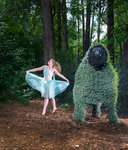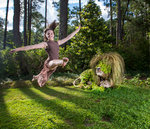


If you want to go on a safari, you won’t have to go to Kenya and watch a lion eat a gazelle. Or even to the North Carolina Zoo in Asheboro and hope the elephants come out of hiding.
Instead, stay in Fayetteville and take a stroll at Cape Fear Botanical Garden, where you’ll discover another type of life form.
In the “Garden Gone Wild” exhibit, you’ll experience a topiary collection of jungle animals sculpted with live plants. You’ll see the “king” of the garden: a lion created with 358 plants. Eighty-eight Carex flagelliform plants alone make up its mane, which sometimes flows in the occasional hot summer breeze.
Then there’s the more common cardinal, found throughout the United States, Canada, Mexico and Central America. It took 150 begonia dark-leaf red plants to create its red feathers. Dyed reindeer moss fills in the areas not covered by plants.
In all, seven species of animals make up the 11 live-plant topiary sculptures that are throughout the garden’s walking trail where you might least expect them. They range from 4 to 12 feet high. The lion is about the size of a conference table. The exhibit includes butterflies, a cardinal, gorillas, a giraffe, elephants and a lion.
The topiary exhibit opened in July and will remain at the garden until the end of December, says Sheila Hanrick, director of events and marketing at the garden. The exhibit is her brainchild.
“Two years ago, I was trying to find large topiary forms that we could cover in lights for Holiday Lights in the Garden. I love animals, and I knew that was the closest I was ever going to get to a large animal in the garden,” Hanrick says.
She couldn’t find one nearby, but luckily botanical gardens throughout the U.S. are like family and are willing to share. She contacted several gardens, including the 128-year-old Franklin Park Conservatory and Botanical Gardens in Columbus, Ohio.
Franklin Park had what she was looking for.
“Their ‘hort’ (horticulture) staff create, maintain and build all of these topiaries. When I reached out to them, they said, ‘As a matter of fact, we have now created enough of these that we are putting them out on exhibit at other gardens — traveling exhibits,’” Hanrick says.
“We rent them from Franklin Park,” she says. “We’re only the second botanical garden to have these.”
The topiaries are called mosaic topiaries, says Chris Hoffman, the garden’s chief executive officer. The sculptures consist of wire frames with special soil mixtures and reindeer moss packed inside.
Unlike traditional topiary arts sculpted from a single bush or tree, mosaic topiaries are made up of a variety of plants to create a three-dimensional visual art form.
Hoffman says the mosaic topiary creators used 13,000 individual plants and seven different plant species.
Using annual and perennial plants allows an artist to create these sculptures faster, but they also need more care. Watering and replacing damaged plants in art that is alive becomes maintenance-intensive.
Hoffman says the opening weekend was a huge success. The topiaries arrived on July 8, and the garden hosted a preview for donors.
“We opened to the public on July 15. The first weekend, we had over 1,000 people attend, and visitors especially enjoyed a demonstration by topiary artist Mike Gibson.’’
Gibson is the topiary artist-in-residence at Pearl Fryar Topiary Garden in Bishopville, South Carolina. He practices a different form of sculpting topiary in which he manipulates living plants.
Since then, Hoffman says, the garden has had more families visit despite this summer’s three-digit heat wave.
The topiaries are a hit with participants of the garden’s classroom camps, where 5- through 8-year-olds learn about animals and conservation.
The topiaries will be at the garden through the end of December, Hanrick says. As the plants begin to die after the first frost, the garden staff will incorporate them into two signature garden celebrations: Halloween in the Boo-tanical Garden and Holiday Lights in the Garden.
“Some of them are not hardy, and when we have our first frost they will do what plants will do,” Hoffman says.
Asked if the garden could create its own topiary art, Hoffman says it’s possible. But there’s a cost associated with doing so, and it requires the skills to build the frames and have the artistry and craftsmanship as well. Part of the reason for the topiary exhibit is to gauge interest and responses, he says. “That may guide us going into the future.’’
Hoffman, who has a background in landscape architecture, came to the botanical garden on May 20. He’s a Texas native transplanted to Mississippi for 30 years. Hoffman worked at the botanical garden at the Oklahoma City Zoo.
His personal goal for the garden is akin to the garden’s mission, to connect people with plants and nature. “Having exhibits helps keep the garden fresh by having something new to explore and enjoy,” he says.
Upcoming at Cape Fear Botanical Garden
Oct. 27: Dog Night in the BOO-tanical Garden
Oct. 28-30 : Halloween in the BOO-tanical Garden
Dec. 1: Member night at Holiday Lights in the Garden
Dec. 2-4, Dec. 9-11, and Dec. 16-22: Holiday Lights in the Garden:
Contacts: capefearbg.org or 910-486-0221